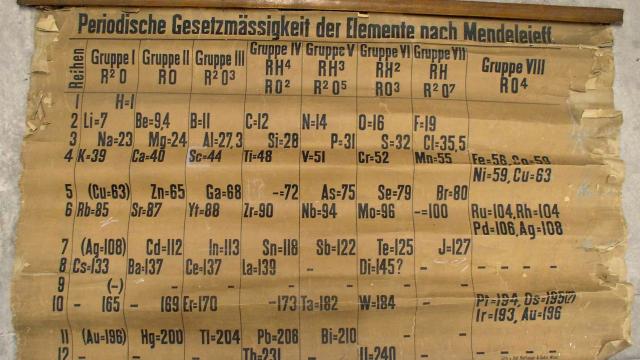A classroom chart bearing an early version of the periodic table of elements has been discovered in a University of St. Andrews chemistry lab. Dating back to the 1880s, the chart is thought to be the world’s oldest.
The storage room of the chemistry department at the Scottish university hadn’t been properly cleaned since the facility opened in 1968, prompting a months-long effort to tidy up back in 2014, according to a news release issued today by the University of St. Andrews. Among all the clutter that had collected over the years was a stash of rolled-up teaching charts.
When chemist Alan Aitken unfurled one of these charts, he saw an old-fashioned version of the periodic table of the elements. At top was a title written in German: “Periodische Gesetzmässigkeit der Elemente nach Mendeleieff,” which translates to “Periodic Regularity of the Elements according to Mendeleev.” The table was extremely brittle and fragile, and some pieces crumbled in Aitken’s hands during this initial handling. The poor condition of the chart, along with its archaic table of elements, led to suggestions that it was very old.
A detailed investigation into the chart and its origins has affirmed these suspicions. Yes, the chart is very old, dating back to 1885, according to the university. Not only that, it’s now the oldest known classroom chart displaying the periodic table of the elements.
The periodic table was first developed by Russian chemist Dmitri Mendeleev in 1869, who revised the chart in 1871. The newly discovered chart is quite similar to the revised version, but with important differences. As the St. Andrews release explains:
[The] St. Andrews table was clearly an early specimen. The table is annotated in German, and an inscription at the bottom left – ‘Verlag v. Lenoir & Forster, Wien’ – identifies a scientific printer who operated in Vienna between 1875 and 1888. Another inscription – ‘Lith. von Ant. Hartinger & Sohn, Wien’ – identifies the chart’s lithographer, who died in 1890. Working with the University’s Special Collections team, the University [of St. Andrews] sought advice from a series of international experts.
Following further investigations, no earlier lecture chart of the table appears to exist. Professor Eric Scerri, an expert on the history of the periodic table based at the University of California, Los Angeles, dated the table to between 1879 and 1886 based on the represented elements. For example, both gallium and scandium, discovered in 1875 and 1879 respectively, are present, while germanium, discovered in 1886, is not.
A subsequent investigation into the university’s financial records showed that Thomas Purdie, a professor of chemistry there from 1884 to 1909, purchased the chart from a German catalogue in October 1888. The chart itself was manufactured in Vienna in 1885.
With the date and origin of the chart established, St. Andrews officials set about the task of preserving the relic for posterity. The University’s Special Collections team was asked to perform a restoration, with funding coming from the National Manuscripts Conservation Trust.
Working carefully so as not to damage the chart any further, the restorers used brushes to remove loose surface grime and debris. They also removed the chart — ever so gingerly — from its heavy linen backing. Deionized water was applied to remove the years of discoloration, and Japanese kozo paper and wheat starch paste was used to repair tears and gaps in the chart.
As a final step, the restorers created a full-size replica of the chart, which is now on display at St. Andrews. As for the original, it’s now resting safely at a climate-controlled room at the Special Collections facility. Hopefully it won’t be forgotten for another century.
